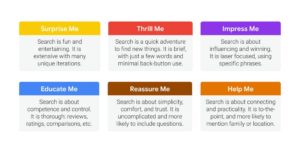SEO 101: Everything You Need to Know About Keywords
Keywords aren’t what they used to be.
In large part, that’s thanks to Google’s search algorithm updates—most recently, RankBrain and BERT. The artificial intelligence (AI) and machine learning algorithms driving modern search engines enables them to learn which details users are actually looking for and serve up just the right results.
Because of that, effective search engine optimization (SEO) practices have shifted from using keywords as the foundation of content, to building the highest-quality pieces that give users exactly what they need. Now, in an age where quality is king, keywords are just one small slice of the SEO landscape.
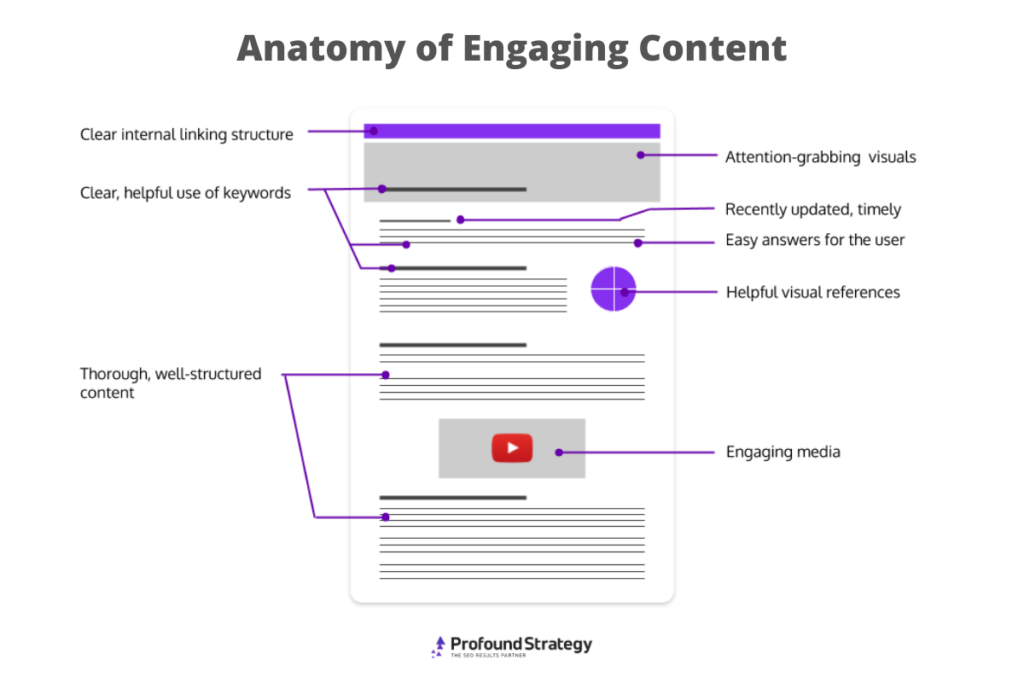
What Are SEO Keywords?
SEO keywords are the terms and phrases marketers use in order to help people find their content via search engines.
For decades, keywords were the driving force behind an SEO strategy. They were (and, too often, still are) the foundation of an SEO content strategy, the topics marketers wrote about, and the way they understood the intersection of the target audience and organic search.
Today, SEO keywords are still valuable, but only as the first step to a truly effective SEO content strategy.
Keywords and queries are codes that search engines—and, thus, digital marketers—use to begin to understand what a target audience really wants, and so, how to create content that connects.
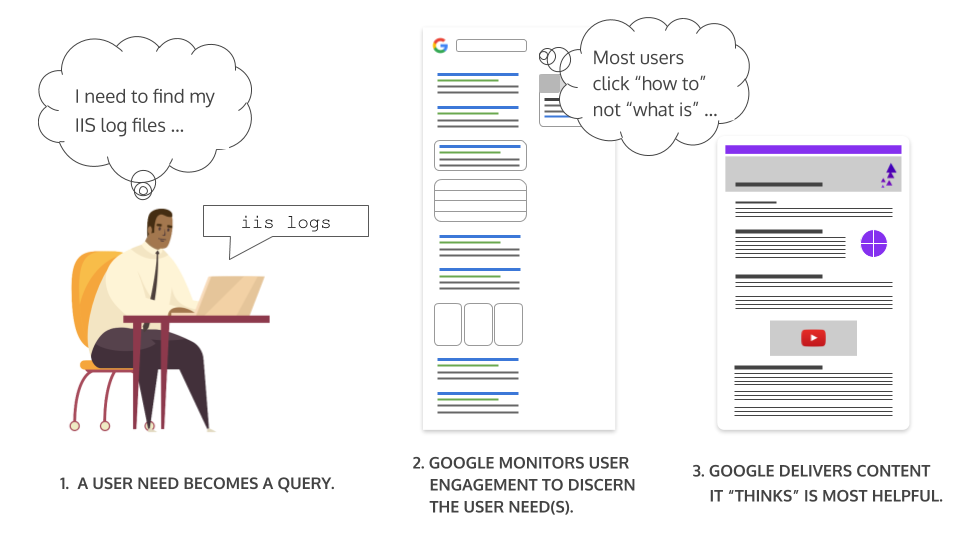
The Purpose and Evolution of SEO Keywords
Keywords have always been a sort of special language that people and search engines use to communicate with each other.
And, like most languages, keywords—and their role in SEO—have evolved.
In the early days of search engines, users could only find what they were looking for if they knew or guessed at the right keywords. Google would evaluate content for not only exact matches of users’ search queries, but how often they appeared on the page, and if synonyms and related terms popped up, too. The more of those boxes a piece of content checked, the more likely Google was to rank it highly, and the more likely users were to see it.
As Google’s dominance grew, the ability to appear in organic search results grew more economically valuable. Soon, an industry bloomed around SEO tools and techniques.
However, some SEO practitioners developed spammy, “black hat” techniques to try and take advantage of the way Google valued keywords in its ranking system. Leveraging ranking factors like keyword frequency, these black hats turned to practices such as keyword stuffing—excessive, unnatural use of keywords, especially in places important to web crawlers, like headlines and meta descriptions—to push content that wasn’t relevant to searches, stealing traffic from better-quality pages.
Over the years, Google has pivoted, releasing updates to punish those cheap, black-hat SEO tricks and reward quality content.

Some of the biggest updates have, naturally, had major impacts on SEO keywords:
Panda: The first major update based on machine learning; it essentially runs in the background to continually improve the search algorithm. There have been many updates to Panda since its 2011 debut, but Panda 4.1, released in 2014, penalized keyword stuffing, affecting 3 to 5 percent of queries.
Penguin: Though Panda 4.1 was meant, in part, to punish keyword stuffing, Penguin, released in 2012, was the first algorithm update to target the black-hat technique. Its initial roll-out impacted roughly 3 percent of queries.
Hummingbird: A key impact of Hummingbird, released in 2013, was how it affected semantic search. Rather than returning results that were a literal match to a query, Hummingbird enabled Google’s search algorithm to consider the context behind a search. For instance, if someone searched “software as a service” (or “SaaS”), Google could infer the user’s true search intent, displaying results that provided a variety of information, including a definition and SaaS companies. The change affected 90 percent of queries.
With updates like these, Google has been signaling that keywords are just the first step in understanding searchers’ needs, and marketers should take notice. The message is clear: Keywords alone don’t matter—it’s what they represent.
A Modern Understanding of SEO Keywords: They Still Matter, But They’re Not Enough Anymore
As long as people use words to search, keywords will have a role to play in SEO. But today, Google is continually updating its search algorithms to suss out what users are really looking for when they use certain terms.
The first stop on this journey of algorithms understanding users is called search (or “user”) intent. To better understand this intent, Google categorizes searches into four simple, common motivations:
- Know — Informational searches that help someone learn about or better understand something they heard, saw, or read
- Go — Navigational searches typically related to destinations and local events or places
- Do — Searches related specifically to tasks; these searches often bring up how-to videos or instructional articles.
- Buy — Searches in the final steps of a buying cycle; includes comparisons, pricing, and more.
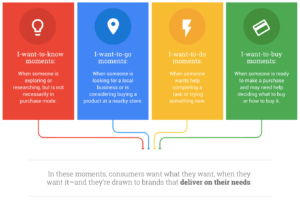
But even Google knows that search intent is just one part of the equation. Smart marketers have been drilling down into user need for years, and Google is starting to quantify these nuances as well.
Google is currently only categorizing user needs for consumer queries, but the strategy applies just the same to B2B SEO.
It is important to note that one keyword is usually associated with more than one user need. Different users may search the same terms for different reasons. In those cases, SERPs will display organic results that answer two or three basic needs.
Keyword to Search Intent to User Need: A Use Case
For example, consider a tech company that sells data integration solutions. They want to improve visibility in organic search, and drive qualified traffic to the site, for “data integration.”
Keyword: data integration
Because this is the brand’s core product, the marketing team gets to work “optimizing” product and solutions pages for “data integration.” They want people who search “data integration” to land on that product page.
Months go by, and it’s not working. Neither rankings nor traffic have improved. Why?
Conduct a depersonalized search for “data integration,” and the answer is obvious: The vast majority of content on the SERP—from page titles, to images, to meta descriptions and scraped text—is answering, “What is data integration?”
Search intent: Know
The user who types “data integration” into a search bar isn’t looking for a solutions platform, he or she is looking for a definition and some basic information. That means that no matter how much those marketers “optimize” their data integrations solutions page it will never perform well for that keyword. Because it’s simply not answering the user’s question.
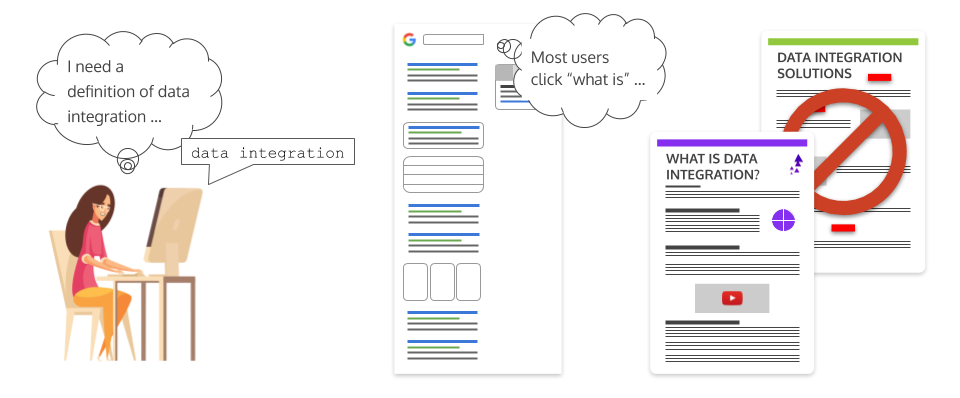
Assume our marketers go back to the drawing board, and create a really great resource article on, “What is Data Integration?” They “optimize” it, publish it, promote it, and wait. Maybe, after a little time, it starts showing up on page three, but it’s not moving up and it’s not driving traffic. Why?
It might be answering the user’s intent, but it’s not meeting the user’s need better than existing content.
Repeat that depersonalized search—or use an SEO tool that provides unbiased ranking information—and open the top five organic URLs. This is the content that users like best, so this is the content Google likes best.
User need: I need a definition and brief overview of data integration.
Investigate and gather insights. What is all of this content doing that yours is not? Those are the keys to answering user need.
SEO professionals who spend less time optimizing for keywords and more time understanding the needs tied to keywords are better prepared to deliver content that will rise to the top of organic search results.
How Do I Find SEO Keywords?
While SEO keywords are no longer enough to build an effective SEO content strategy, they are still the foundation and first step to discovering user needs. That means we still have to get them right.
Identifying the right SEO keywords for any business or service starts with exploring how the target audience thinks. What are their motivations? What’s important to them? What would trigger them to search?
Combining these questions with some helpful tools can help you brainstorm a list of keywords that fit the buyers you’re looking to attract. Some of those tools include:
Auto-complete text: These are the suggestions Google provides as a user is typing a search query. For instance, if a user enters “data silos,” the search engine might auto-complete with words like “data silos in healthcare,” “data silos vs data lakes,” or “data silos meaning.”
Note that Google takes your previous searches into account when generating autocomplete text, so it likely won’t represent what your prospect sees. Workarounds include depersonalized searches and tools like Keywordtool.io that show possible autocomplete suggestions.
Google’s Search Engine Results Page (SERP): Some SERP features can help expand your list of keywords. One is a list of related terms at the bottom of the page. Google generates this list based on what others have searched for:
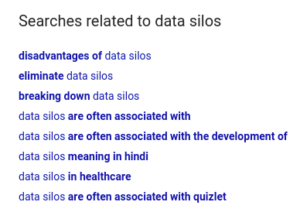
The other is the “People also ask” section of a SERP, which generates other questions or searches linked to the immediate query.
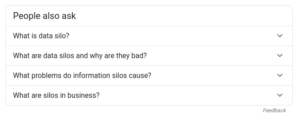
Both of these features can help you create a useful set of alternatives.
Keyword search tools: A variety of professional tools exist that can help SEOs and marketing professionals sort and prioritize keyword options:
Google Analytics helps identify keywords that already generate traffic for your content.
Google Trends illustrates the relative search volume for certain terms over time. It’s helpful for understanding and tracking a keyword’s popularity. Some terms can be on the decline or take on new meaning based on news or popular culture.
SEMrush is a professional tool for analyzing search by domain and various other factors. Generally a paid service, but it does include a free option.
seoClarity not only pulls from a database of keywords that is updated monthly, it also identifies semantically related keywords based on top organic results.
But just developing a list of keywords isn’t enough. It’s critical to organize search terms in a way that’s helpful to your content strategy.
Verify SEO Keywords
It’s easy to end up with a huge list of keywords before too long, so make sure to validate the keywords as you build a list. A valuable keyword will have three characteristics:
- Search volume — There are several tools that will report how many times a keyword is searched every month. What is “enough” will vary for each brand, but no marketer needs to spend time investigating keywords that simply are not being used.
- Brand relevance — Make sure the term—as Google understands it, not as your team understands it—is relevant to the business. Sometimes a potential keyword looks good in a tool, but it’s actually the name of a company or a book. Don’t waste time on those.
- Business value — As you investigate the user need associated with a keyword ask if you’re seeing your target audience in SERPs. It’s not worth winning in search for a term that never drives business value.
Be careful on the question of business value. Some marketers quickly dismiss top-of-funnel terms that are associated with entry-level user needs. Those users might not be ready to buy today, but they might also be at the very beginning of a decision. If so, you want to be there.
What Are Long-Tail Keywords?
Long-tail keywords are search terms that typically consist of four or more words and are often specific phrases or questions.
Take the search term “workflow management.” In this case, “workflow management” is the main keyword, or head term. “Workflow management” plus any other words and phrases would be long-tail keywords. Examples might be:
“workflow management software”
“workflow management definition”
“workflow management software free”
Upwards of 50% of searches are based on long-tail keywords using four or more words. That’s largely thanks to the rising popularity of voice search via tools like Google Assistant, Siri, and Alexa. People are increasingly comfortable with virtual assistants, so they speak naturally in voice search tools.
To find long-tail keywords, use a combination of research tools, plus insights gleaned from environments where you and your team interact directly with your customers. Chat-bot dialogs, Facebook group comments, and email capture the expressions customers use to describe your product and its features and functions.
Help build and prioritize your keyword list with our long-tail keyword worksheet template. →
How to Leverage Keywords in Your SEO Content
The #1 rule for using keywords in SEO content is to put the reader first and use them naturally. Google likes what users like, so shortcutting the system never works for long.
With that in mind, there are places you can use keywords to indicate to users and search engines that your content has what people are looking for.
H tags — H tags, or heading tags, are the bits of HTML code that format text as a headline or a subheading on your page. Google probably uses an article’s headings to determine its subject matter, but more importantly, people use headings as guideposts to quickly scan a page to see if it addresses their questions and problems.
URLs — Though you can change URLs, they tend to be static and are highly visible, so Google pays attention to their content. Plus, if a URL is simple, to-the-point, and contains target keywords, it gives users an added reassurance that the page has the information they need.
Meta descriptions — Meta descriptions don’t influence Google rankings, but using keywords in them signals to readers that your piece answers their questions. Thus, a good meta description that uses keywords strategically can increase click-through-rates (CTR) from search results.
Static content — Search engines have an easier time indexing static content, or content that doesn’t change each time a page loads, as opposed to dynamic content. To leverage this, use keywords and phrases clearly in static portions of your page.
Internal links — When linking back to your own content, make sure the link’s anchor text incorporates your keywords or related synonyms in a natural way. When other pages use your target keywords in their anchor text, it helps Google recognize that your page is closely tied to those words and that topic.
Alt text — Including alternative, or alt, text with image, video, and other multimedia files ensures that those with vision impairments can access your content. An additional benefit is that alt text also helps web crawlers understand, index, and rank that content.
Beyond SEO Keywords
Search engines are getting better and better at parsing the pain points behind a user’s search terms and serving up content to meet those needs. To keep up, SEOs need to get a handle on those intents and needs too. Understanding how keywords work is simply the first step.
Exploring the larger SEO landscape can open up a new world of effective, modern keyword and content strategy. Learn more about how to create the best content for your customers with our Modern Guide to High-Impact SEO Content, or contact Profound Strategy today.
